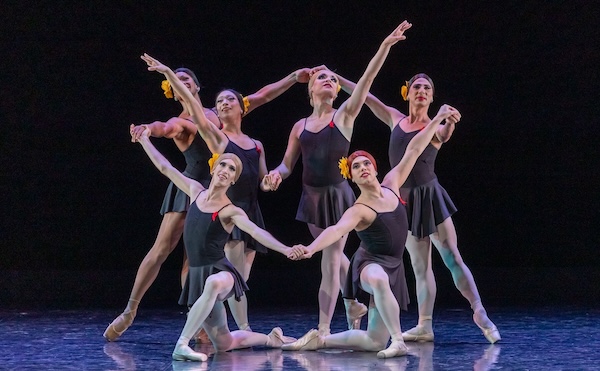Dance Review: Les Ballets Trockadero de Monte Carlo at 50 — A Legacy of Dance, Humor, and Familiar Jokes
By Christopher Caggiano
After five decades of blending strong technique with playful satire, the Trocks continue to impress, but some of their once-fresh humor feels a bit played out.

The Dying Swan, Olga Supphozova. Photo: J.R. Marrero
Les Ballets Trockadero de Monte Carlo’s current run at the Joyce Theater in New York City marks the troupe’s 50th anniversary. It is an achievement that reflects the troupe’s impact on both the world of dance and the LGBTQ+ community. For half a century, the Trocks have entertained audiences with their signature mix of classical ballet and comedic parody.
As the first all-male company to adopt the toe shoes and tutus of classical ballerinas, the Trocks redefined the art form and opened doors for a more diverse range of performers to enter the world of professional dance. Today, the Trocks remain trail blazers — their appeal is rooted in both technical prowess and a commitment to inclusivity.
I saw Program B, one of the two programs playing through January 5th at New York’s Joyce Theater. This particular lineup showcases the company’s knack for blending parody with rigorous technique. It’s clear that the Trocks have not lost any sharpness when it comes to executing intricate choreography. The swan queen in the Trocks’ version of “Swan Lake” was particularly impressive. Going by the joke stage name of Anya Marx (as in “On your marks…”), performer Shohei Iwahama demonstrated a particularly notable precision of movement and range of expression.
However, while overall the dancing was as tight and polished as ever, I couldn’t help but reflect on how the troupe’s humor has evolved over the decades – or, perhaps, hasn’t evolved. I first saw the Trocks in the ’90s in Boston, and I remember being charmed by their flair for farce. The physical humor and playful critiques of ballet felt fresh, even daring. At this point, the group has spent 50 years parodying many iconic dance works, and I couldn’t shake the feeling that the troupe has come pretty close to exhausting its well of humor. The comedy, while still enjoyable, often felt familiar and predictable, relying on tropes that might have been more on point decades ago.

Go for Barocco. Photo: Jose Luis Marrero Medina.
I also got the creeping sense that the experience would be more enjoyable for people who are well versed in dance history. For example, the Trocks’ truncated version of Swan Lake left me wondering if someone who had never seen the full ballet would be at a loss about what was happening and why it was funny. I was a bit hazy on the plot myself (It’s been a while) and was left wondering how the whole thing ended.
Similarly, because I have a bit of dance knowledge, it was clear to me that the “Yes, Virginia, Another Piano Ballet” section was a playful send-up of Jerome Robbins’ “Dances at a Gathering.” I relished the humor because I knew the source material. However, if you weren’t familiar with Robbins’ work, it may have elicited more of a shrug than a chuckle.
And sometimes the sequences go on a bit longer than is probably wise. A modern piece in the second half of Program B (the program notes listed only “Pas de Deux, Solo, or Modern Work to Be Announced”) featured a minimalist dance accompanied by sound effects from two performers seated downstage left. It was intended to be a send up of the pretension that some dance companies exhibit in deliberately choosing unconventional or even off-putting “music.” While the idea was amusing, the joke soon wore thin.
Despite these critiques, it’s important to acknowledge that the Ballets Trockadero de Monte Carlo remains a groundbreaking company. The level of technical expertise is still spot-on, and the troupe’s ability to blend serious dance with lighthearted hijinks remains impressive. While its humor may have lost some of its edge over the years, the troupe’s legacy for both elevating and gently mocking dance — while also making it more inclusive and accessible — is as strong as ever.
Christopher Caggiano is a freelance writer and editor living in Stamford, CT. He has written about theater for a variety of outlets, including TheaterMania.com, American Theatre, and Dramatics magazine. He also taught musical-theater history for 16 years and is working on numerous book projects based on his research.
